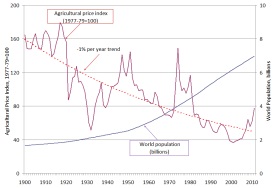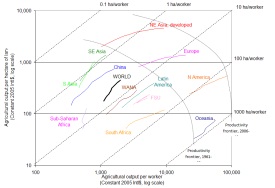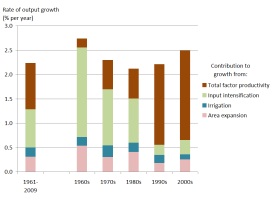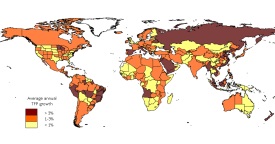
Improving agricultural productivity has been the world’s primary defense against a recurring Malthusian crisis—where needs of a growing population outstrip the ability of humankind to supply food. Over the last half-century, world population doubled while food supply tripled, even as land under cultivation grew by only 12% (FAO, 2012). It is by raising productivity, or getting more output from existing resources, that has been driving growth in global agriculture, and what has proven Malthus wrong. In fact, at the global level, the long-run trend since at least 1900 has been one of increasing food abundance—in inflation-adjusted dollars, food prices fell by an average of 1% per year over the course of the 20th Century (Figure 1).

The agricultural price index is the Grilli-Yang composite
price index of 18 crop and livestock commodities, each
weighted by its share of global agricultural trade in 1977-79
(S. Pfaffenzeller, P. Newbold, and A. Rayner, World Bank
Economic Review 21(2007):151-63), updated with data from
International Monetary Fund Primary Commodities Prices and
adjusted for inflation using the U.S. Gross Domestic Product
implicit price index. World population estimates are from the
United Nations, World Population Prospects: The 2010 Revision.
Source: Fuglie and Wang (2012).
But since around 2001, real food prices have been rising. While demand-side factors—continued population growth, greater per capita consumption of meat, diversion of crop commodities for biofuel—and weather-induced production shocks—like the 2012 drought in North America—are generally thought to be the major forces behind these rising prices (Trostle, et al. 2011), the persistence of high prices has renewed concerns about whether agriculture is facing new constraints on supply growth. In particular, if agricultural productivity is reaching its limit, it may harbinger even further increases in commodity prices, rising food scarcity, and increased competition for land, water and energy resources. In fact, for major cereal grains like wheat and rice, average rates of yield growth have slowed from about 2% per year in the 1970s and 1980s to about 1% per year since 1990. There is also evidence that growth in agricultural total factor productivity (a broad measure of sector-wide productivity) may have slowed down in some developed countries (Choices, 2009).
This article provides a reassessment of agricultural productivity growth at the regional and global levels, drawing on 15 case studies newly published in Fuglie, Wang, and Ball (2012). In recent decades world agriculture has undergone some fundamental changes. One has been that many developing countries have greatly expanded their capacities in agricultural research and innovation, providing many new improvements in farming technologies and practices (Pardey and Bientema, 2001). Complementing this expanded research capacity have been institutional and policy reforms, improvements in farmer education and health, and investments in rural infrastructure, all of which help create an environment in which new farm technologies and practices are adopted more rapidly. A second major development has been the shifting location and composition of global agricultural production. With slower agricultural growth in developed countries and—following the collapse of the USSR—a significant contraction in agricultural output in former Soviet bloc countries, developing countries now account for about two-thirds of global agricultural output—up from 42% in 1961 (FAO, 2012). Further, as rising incomes in developing countries lead to changes in the kinds of foods consumers demand, the share of staple food commodities in world agriculture has declined. The share of global agricultural output contributed by cereal grains and root and tuber crops fell from 30% in the 1960s to 24% in 2010, while the gross value share in fruits and vegetables increased from 18% to 22%, and the share in oil crops rose from under 5% to nearly 8% (FAO, 2012). Meanwhile, the crop-animal shares of gross agricultural output have remained stable, at roughly 63% in crops. These developments suggest that the global picture of agricultural productivity depends heavily on how it evolves in developing countries and amongst a broad set of commodities, not just food staples.
The 15 case studies published in Fuglie, Wang, and Ball (2012) investigate agricultural productivity growth and its drivers across a broad swath of the globe. Included are developed countries (the United States, Western Europe, Canada, Australia and South Africa), developing countries and regions (Brazil, China, India, Indonesia, Thailand and Sub-Saharan Africa), and transition countries (Eastern Europe and the former Soviet Union). Taken together, the case studies point toward robust but highly uneven productivity growth in global agriculture.
International comparisons of productivity usually begin by comparing agricultural land and labor productivity, like the kind popularized by Hayami and Ruttan (1985) and depicted in Figure 2.Over the past 50 years, the highest levels of agricultural output per worker and per acre of agricultural land have been consistently achieved by industrialized nations. Currently, the world’s highest yields—gross output of crops and livestock per hectare of land—are found in the developed countries of northeast Asia (Japan, South Korea and Taiwan), while the highest output per agricultural worker is in North America (the United States and Canada) and Oceania (Australia and New Zealand). Developing countries lag far behind, but in recent decades they have been slowly catching up. Developing countries are currently at levels achieved by industrialized nations in the 1960s, suggesting that large global productivity gaps persist among countries.

Agricultural output is FAO Gross Agricultural Output in
constant 2005 international dollars; agricultural land (total
cropland and permanent pasture) and labor (number of
economically active adults employed in agriculture) are also
from FAO. Each arrow represents a five-year average value
starting with 1961-65, then 1966-1970, and so on until ending
with 2005-10. The diagonal dashed lines depict constant
land/labor ratios in hectares(ha)/worker. WANA = West Asia
and North Africa; FSU = Former Soviet Union. NE Asia,
developed includes Japan, South Korea and Taiwan.
Source: Fuglie, Wang and Ball (2012).
Much of the gains in land and labor productivity shown in Figure 2 came from more intensive use of other inputs—such as fertilizers, machinery, energy and irrigation. A broader concept of agricultural productivity is total factor productivity (TFP), which is the ratio between total outputs of crops and livestock to total inputs—an aggregation of all of the land, labor, capital and materials used in production. Growth in TFP is then the difference between aggregate output growth and input growth. In practice, measuring TFP is a data intensive exercise requiring detailed historical statistics on the quantities and prices of outputs and inputs, and the use of appropriate index methods to account for input and output substitution possibilities as relative prices change. Moreover, empirical measures of agricultural TFP rarely account for quality improvements in inputs or changes in natural resource stocks—such as biodiversity, water quantity and quality, and greenhouse gas emissions—that result from agricultural activity. However, while agricultural production is generally thought to draw down these natural resource stocks, what this implies for TFP is not immediately evident. While the evidence is far from complete, some studies suggest that productivity improvement in agriculture has significantly reduced negative environmental externalities from agriculture—and thus conventional measures underestimate growth in TFP—through averting forest-to-cropland conversion (Stevenson, et al. 2011) and reducing greenhouse gas emissions per ton of meat and milk output from ruminant livestock (Burney, Davis, and Lobell, 2010). On the other hand, the expansion of large-scale, confined hog feeding operations in the United States has been a significant part of TFP growth in this industry (Key, McBride, and Mosheim, 2008), but the concentration of wastes from these operations poses greater risks for water (Key, et al. 2011) and air pollution (Sneeringer, 2009).
Table 1 provides a number of productivity measures for the global agricultural economy as a whole, by decade since 1961, including TFP. Output growth has remained remarkably constant over these decades, averaging 2.7% per year in the 1960s and between 2.1% to 2.5% per year every decade since then. Growth in agricultural yield—total output per hectare of agricultural land—has mimicked the trends in output growth, remaining fairly steady over the past 50 years around an average of 2.1% annually. The growth rate in cereal yield per area harvested, however, has shown signs of slowing after 1990. One reason the decline in area harvested yield is not reflected in total agricultural yield is because of land-use intensification. More double cropping and less idled or fallow cropland means more harvests in a year, on average, per hectare of cropland. This can keep cropland productivity rising, even if yield per harvest is stagnant. The decline in cereal yield growth is also being offset by other productivity improvements in the sector—such as rising yield growth in other crop commodities, and more meat and milk output per animal, acre of pasture, and pound of feed—to keep total output per hectare of agricultural land rising at historical rates.
The TFP measure of productivity change captures a broader set of productivity improvements—including those that save agricultural resources other than land. It does not count as productivity growth simple substitution between inputs—fertilizer for land or machinery for labor, for example, if this doesn’t save costs. Thus, TFP provides a better measure of the underlying rate of technical change. And according to our estimates, the average rate of technical change (TFP) in global agriculture rose significantly over the past half-century. The growth rate in aggregate inputs used in agriculture, meanwhile, fell steadily. Over the past five decades, the source of growth in the global agriculture output has shifted dramatically from being primarily resource-driven to primarily productivity-driven.
| Period | Gross output |
Total input |
Total factor productivity | Output per worker | Output per area of cropland | Cereal yield per area harvested | |
| Average growth rate (% per year) | |||||||
| 1961-1970 | 2.74 | 2.55 | 0.18 | 1.13 | 2.45 | 2.88 | |
| 1971-1980 | 2.3 | 1.7 | 0.6 | 1.58 | 2.09 | 2.08 | |
| 1981-1990 | 2.12 | 1.5 | 0.62 | 0.62 | 1.75 | 1.88 | |
| 1991-2000 | 2.21 | 0.55 | 1.65 | 2 | 2.16 | 1.57 | |
| 2001-2009 | 2.49 | 0.65 | 1.84 | 2.8 | 2.64 | 1.8 | |
| 1971-1990 | 2.25 | 1.53 | 0.72 | 1.11 | 1.97 | 2.25 | |
| 1991-2009 | 2.29 | 0.7 | 1.59 | 1.97 | 2.27 | 1.42 | |
| 1961-2009 | 2.23 | 1.28 | 0.95 | 1.19 | 2 | 1.99 | |
Gross agricultural output is from FAO and is measured in constant 2005 international dollars. Total input is the aggregation of agricultural land, labor, capital and material inputs. Growth in TFP is the difference between output growth and total input growth. Output per worker is gross agricultural output divided by number of economically active adults working in agriculture. Output per hectare is gross agricultural output divided by total cropland plus permanent pasture. Cereal yield is global output of maize, rice and wheat (in metric tons) divided by the area harvested of these crops. The average annual growth rate in a series (call it Y) is found by regressing its log value against time, i.e., the estimate of parameter β in ln(Y) = A + βt.
Source: Fuglie, Wang and Ball (2012).
Figure 3 decomposes the sources of growth in global agricultural output into contributions from (i) growth in land and water (irrigation), (ii) intensification of other inputs per unit of land, and (iii) TFP. Over these five decades, total inputs grew at about 60% as fast as gross agricultural output, implying that improvement in TFP accounted for about 40% of total output growth. Moreover, TFP’s contribution to output growth grew over time, and by the most recent decade (2001-2009), TFP accounted for about three-quarters of the growth in global agricultural production. The rate of expansion in natural resources used—land and water—has slowed slightly over time, while the rate of growth in input intensification—the amount of labor, capital and materials per hectare of land—has fallen sharply. The source of increase in agricultural yield—output per hectare of agricultural land—has shifted markedly from input intensification to improvement in TFP.
The estimates of global agricultural output and TFP growth are disaggregated among global regions in Table 2. The trends are hardly uniform, but three general patterns are evident:
Total resources employed in agriculture in high income countries have been falling since about 1980; TFP growth offset the declining resource base to keep output from declining. TFP growth has remained robust overall, but has slowed in some countries like Australia and the UK. Labor productivity has been rising much faster than land productivity and average farm size has increased—agricultural labor has been falling more rapidly than land used in agriculture.
TFP growth in developing regions doubled between 1960-1990 and 1991-2009, from less than 1% to over 2% per year. Input growth has been slowing each decade but is still positive, enough to keep output growing at over 3% annually for each of the last three decades. Two large developing countries in particular, China and Brazil, have sustained exceptionally high TFP growth over the past two decades. Several other developing regions—including Southeast Asia, North Africa, and Latin America—also registered accelerated TFP growth in the 1990s or 2000s compared with previous decades. The major exception is Sub-Saharan Africa, where long-run TFP growth has remained below 1% per year.

The height of the bar is the average annual growth rate
in gross agricultural output over the period. The color
components decompose the source of the growth into parts
due to (i) agricultural land expansions, (ii) extension of
irrigation to cropland, (iii) greater use of fertilizer, machinery,
labor, and other inputs per acres of cropland, and (iv) total
factor productivity.
Source: Fuglie, Wang and Ball (2012).
The dissolution of the USSR in 1991 imparted a major shock to agriculture in countries of the former Soviet Bloc. As these countries began the transition from centrally-planned to market-oriented economies, agricultural resources sharply contracted and output fell. Since about 2001, output has begun to expand again, and it appears to be led by improvements in productivity. TFP growth, which was practically nonexistent during the Soviet era, has taken off since 2001. However, gross agricultural output in 2009 was still below Soviet-era levels in every region except Central Asia and Caucasia.
New research has measured agricultural TFP growth not only for all of the world’s nations, but for the various states and provinces of large countries, namely, for China, the United States, Brazil, Australia, and Indonesia (see the chapters in Fuglie, Wang, and Ball, 2012). This work shows that productivity is highly variable not only across countries, but within countries as well (Figure 4). In China, TFP growth has been very strong in coastal areas but slackens in the interior. Coastal states of Brazil have also experienced robust agricultural productivity growth. But unlike China, high TFP growth is also evident in some parts of the interior—like Mato Grosso in the Cerrado, now the main soybean and cotton producing state in the country. In Indonesia, productivity growth has been concentrated in recent years in the western and northern regions of the country—Sumatra and Kalimantan especially—where export commodities like oil palm and cocoa have been booming. In contrast, TFP growth has been low or stagnant in Java and the eastern provinces. This is a sharp departure from the “Green Revolution” decades of the 1970s and 1980s which disproportionately benefitted irrigated rice production, which is especially important in Java. In the United States, productivity growth has been moderately strong in the agriculturally important Corn Belt and Lake States, but low in Plains States, Appalachia and major horticultural producers like California and Florida. While Australian “broadacre” (dryland) agricultural TFP has stagnated nationally, this has primarily affected eastern and southern portions of the country.
| Region | Average TFP growth rate (% per year) | ||||
| 1961-70 | 1971-80 | 1981-90 | 1991-00 | 2001-09 | |
| All Developing Countries | 0.69 | 0.93 | 1.12 | 2.22 | 2.21 |
| Sub-Saharan Africa | 0.17 | -0.05 | 0.76 | 0.99 | 0.51 |
| Latin America & Caribbean | 0.84 | 1.21 | 0.99 | 2.3 | 2.74 |
| Brazil | 0.25 | 0.6 | 3.02 | 2.62 | 4.03 |
| Asia (except West Asia) | 0.91 | 1.17 | 1.42 | 2.73 | 2.78 |
| China | 0.94 | 0.67 | 1.71 | 4.1 | 3.05 |
| West Asia & North Africa | 1.4 | 1.66 | 1.63 | 1.74 | 1.88 |
| All Developed Countries | 0.99 | 1.64 | 1.36 | 2.23 | 2.44 |
| United States & Canada | 1.25 | 1.67 | 1.31 | 2.18 | 2.24 |
| West and Central Europe | 0.58 | 1.44 | 1.43 | 1.25 | 1.98 |
| Transition Countries (former USSR and E. Eur.) |
0.57 | -0.11 | 0.58 | 0.78 | 2.28 |
| World | 0.18 | 0.6 | 0.62 | 1.65 | 1.84 |
Figure 4 also points to improved productivity growth performance in some sub-Saharan African countries. While a few countries appear to have raised their long-term agricultural TFP growth to over 1% per year, others—like Angola—are simply recovering from earlier decades when they were at war. Sub-Saharan Africa remains perhaps the biggest challenge in achieving sustained, long-term productivity growth in its agricultural sector. It is also the region of the world with the highest poverty rate and in the coming decades it is facing the world’s highest population growth rate.
Perhaps the single most important factor separating countries that have successfully sustained long-term productivity growth in agriculture from those that have not is their national capacity in agricultural research and development (R&D). Countries that have built national research systems capable of producing a steady stream of new technologies suitable for local farming systems are generally the ones that have achieved the higher growth rates in agricultural TFP (Evenson and Fuglie, 2011). Evidence reported in the chapters of Fuglie, Wang, and Ball (2012) finds that international and inter-state spillovers of agricultural knowledge are important sources of productivity growth, and that an important role of local R&D is facilitating the “capture” of these spillovers. Local R&D is often critical for adapting technologies developed elsewhere into useable technologies for local farming systems. Being actively engaged with foreign or international research institutions significantly raises returns to national agricultural research. While public-sector investments in agricultural R&D exhibited a slowing rate of growth in the 1980s and 1990s, the most recent evidence suggests that at least in developing countries this trend has reversed (Bientema et al. 2012). In high income countries, some of the stagnation in public agricultural R&D spending has been offset by greater R&D investment by the private sector, although the willingness of the private sector to invest in agricultural R&D may in turn be dependent on continued advances in publicly-funded fundamental sciences (Fuglie et al. 2012)

The map depicts the average annual growth rates in
agricultural TFP between 1995 and 2006-2009
(depending on data) by country, and by state or province
for the United States, Brazil, Australia, China, and Indonesia.
Source: Fuglie, Wang and Ball (2012)
In addition to R&D, new econometric evidence from the Fuglie, Wang, and Ball (2012) volume has identified a number of other factors that have contributed to cross-country differences in agricultural TFP. This can broadly be characterized as the “enabling environment” for the dissemination of new technologies and practices. These factors include policies that improve economic incentives for producers, stronger rural education and agricultural extension services, and rural infrastructure that improves access to markets. At the same time, economically disruptive “shocks,” such as armed conflict and human or animal diseases—HIV/AIDS in Africa and avian flu in Asia—have seriously depressed agricultural productivity growth in some countries. Having a more favorable enabling environment compliments but does not substitute for research. Improving on these enabling factors raises the return to investments in agricultural R&D.
Future challenges to world food security, as in the past, do not appear to be related to technical constraints to raising agricultural productivity at the global level, but rather to uneven access to resources, technologies and food. Regions that have lagged behind the agricultural technology frontier, like much of Sub-Saharan Africa, have remained mired in poverty and food insecurity. These countries could follow the examples of agricultural success stories like Brazil and China, which invested heavily in agricultural research, made critical reforms to policies and institutions, and tapped into international sources of agricultural technology to raise their farmers’ productivity, lower food prices for consumers, and stimulate economic growth. When a country’s population shares broadly in these developments, it can have a major impact on poverty reduction and improving societal well-being.
Alston, J., Babcock, B. and Pardey, P. (eds.). (2010). The shifting patterns of agricultural production and productivity worldwide. Iowa State University, Ames: Midwest Agribusiness Trade and Research Information Center.
Bientema, N., Stads, G., Fuglie, K., and Heisey, P. (2012). ASTI global assessment of agricultural R&D spending: Developing countries accelerate investment. Washington, DC: International Food Policy Research Institute.
Burney, J., Davis, S., and Lobell, D. (2010). Greenhouse gas mitigation by agricultural intensification. PNAS, 107(26): 12052-57.
Choices. (2009). Agricultural productivity and food security in the long run. 24(4) 4th Quarter.
Evenson, R., and Fuglie, K. (2010). Technology capital: The price of admission to the growth club. Journal of Productivity Analysis 33: 173-190
FAO. FAOSTAT agricultural database. (2012). Food and Agricultural Organization, Rome. Accessed October 2012. http://www.faostat.fao.org/.
Fuglie, K., Wang, S.L. and Ball, V.E. (eds.). (2012). Productivity growth in agriculture: An international perspective. Oxfordshire, UK: CAB International.
Fuglie, K., and Wang, S.L. (2012). New evidence points to robust but uneven productivity growth in global agriculture. Amber Waves 10 (September). 6p.
Fuglie, K., Heisey, P., King, J., Pray, C., and Schimmelpfenning, D. (2012). The contribution of private industry to agricultural innovation. Science 338 (23 November): 1031-32.
Hayami, Y., and Ruttan, V.W. (1985). Agricultural development: An international perspective. Baltimore, MD: Johns Hopkins University Press.
Key, N., McBride, W., Ribaudo, M., and Sneeringer, S. (2011). Trends and developments in hog manure management: 1998-2009. Economic Information Bulletin No. 81, Economic Research Service, Washington, DC, September.
Key, N., McBride, W., and Mosheim, R. (2008). Decomposition of total factor productivity change in the U.S. hog industry. Journal of Agricultural and Applied Economics 40: 137-149.
Pardey, P., and Beintema, N. (2001). Slow magic: Agricultural R&D a Century after Mendel. Washington, DC: International Food Policy Research Institute.
Sneeringer, S. (2009). A national, longitudinal study of the effects of concentrated hog production on ambient air pollution. American Journal of Agricultural Economics 92: 821-835.
Stevenson, J., Byerlee, D., Villoria, N., Kelley, T., and Maredia, M. (2011). Agricultural technology, global land use and deforestation : A review and new estimates of the impact of crop research. In, Measuring the Environmental Impacts of Agricultural Research: Theory and Applications to CGIAR Research. Rome, Italy: CGIAR Independent Science & Partnership Council, pp. 49-87.
Trostle, R., Marti, D., Rosen, S., and Westcott, P. (2011). Why have food commodity prices risen again? Outlook Report WRS-1103, Economic Research Service, U.S. Department of Agriculture, Washington, DC, June.